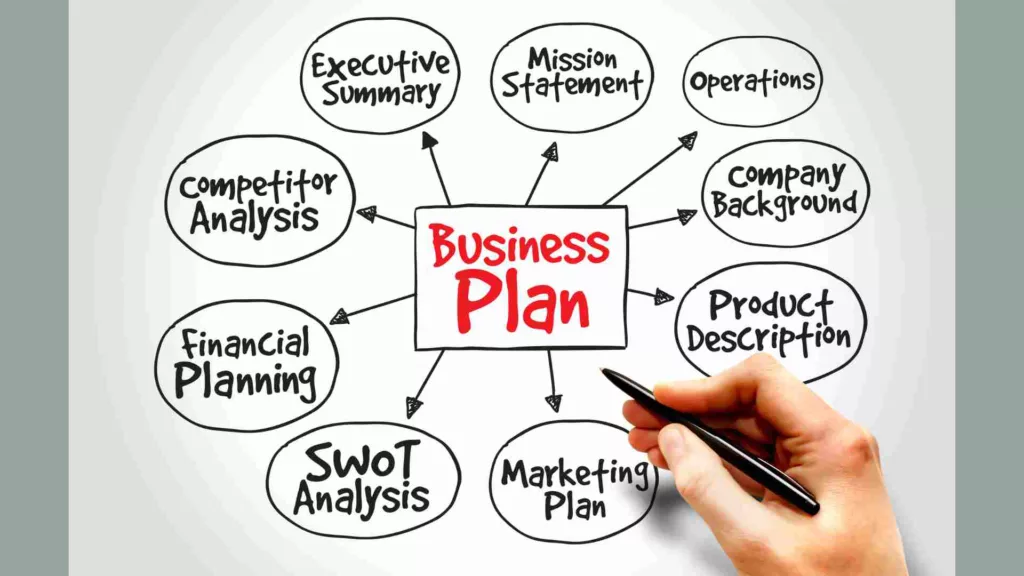Posted in Blog, Entrepreneurship, Innovation, Launch Your Business by Jo North
Your Business Plan Template: An Introduction
This article offers a free business plan template, tailored for both existing businesses that want to grow, and lean startups.
Every entrepreneur and innovator requires a solid business plan to guide their endeavors. Whether you’re a seasoned business owner, innovator or new to the scene.
I’ve helped many organizations of all kinds and sizes from around the world to create their business plan. I hope you find my tips, template and guidance useful.
We’ll start with an overview, and then I’ll go into some hands-on activities that you can do to create your business plan outline and content quickly and easily.
Business Planning Overview
Why a Business Plan?
A business plan should be a well-written document that provides a clear understanding of your business objectives, strategies, and the value proposition you’re offering to your current and potential customers.
The First Steps
Starting with an executive summary, a business plan gives an overview of what the business entails. The company description and company overview provide detailed information about the nature and type of business. Before embarking on your venture, understanding the target market is essential. Market research and market analysis reveal market size and the needs of your target audience.

Essential Elements of a Business Plan
Every thorough business plan should cover the following sections:
Sustainable Business Model
This illustrates how the business intends to make money. It includes potential revenue streams and the value proposition to target customers. With today’s climate change challenges, and increasing consumer demand for green, ethically produced products and services, you need to innovate a sustainable business model.
External Environment and Future Trends
The external environment is the world outside your business. It includes everything you can’t control, like economic conditions, competitors, and customer behavior. Future trends are the directions in which these elements are heading.
Understanding these two things can help you spot opportunities or threats early on. It can guide where you take your business and how you adapt.
By including content on the external environment and future trends in your business plan:
- You show investors you’ve done your homework.
- You prepare your business for what’s coming.
- You can make informed decisions.
- You stand out from competitors who might not be looking ahead.
In short, it helps your business be proactive, not reactive. It’s a step toward success.
Marketing Plan
Your marketing plan details your marketing strategy and tactics for attracting new customers and retaining them. This section will also cover different marketing strategies for different market segments.
Financial Plan
Your financial plan includes financial statements such as balance sheets, income statements, and cash flow statements. This plan shows the financial projections of your business and helps secure funding from financial institutions.
Management and Team
Information about team members, the management team is important to give your plan credibility.
Operational Plan
Delve into the daily operations of your business. If you’re seeking a business loan, this section is vital.
SWOT Analysis
It’s essential to understand the strengths, weaknesses, opportunities, and threats of your business.
Sales Strategy
Your sales strategy guides how you’ll attract new and existing business, including a detailed sales plan. It includes your sales channel and pricing strategies.

Business Plan Formats
There are two main types: the detailed business plan and the one-page business plan template. While both provide a framework, the main difference is the depth of information.
Lean startup business plans are shorter, suitable for businesses that require agility. A traditional business plan format is comprehensive, preferred by business leaders and financial institutions.
Resources for Entrepreneurs & Innovators
This article offers a free template for both types of business plans. There are also sample business plans for different types of businesses. For those wanting to go beyond a single plan, there’s guidance on creating a more detailed business plan.
Tips for Success
- Target the Right Audience: Ensure your business idea resonates with potential customers.
- Financial Clarity: Your financial data should be clear for potential investors.
- Consistency: Maintain a consistent color scheme and format.
- Use Professional Help: For legal documents and intellectual property, don’t hesitate to use a service provider.
- Have a Business Strategy Workshop with your team.

Creating a professional plan is the best way for small business owners to secure funding, communicate with business partners, and have a roadmap for success. Whether you’re launching a new venture or growing an existing business, this template is a great place to start.
Your Business Plan Template
Every small business needs a business plan. It’s important to create one for your business if you don’t have one already and keep it up-to-date.
Writing a business plan for your company or innovation is not always an easy task, but there is a multitude of reasons that you need to have one, nonetheless. It’s a myth that the only times you will need a business plan are when you’re going to ask for a loan, pitch for an investment or launch a start-up.
This article focuses specifically on how to create a business plan for growth, rather than for investment pitches or finance and loan applications.
Create a Living Roadmap for Growth
A good business plan for growth includes your goals, strategies, sales, marketing and financial forecasts for the future, and is a living roadmap that helps you keep your business growing and developing in the direction you want it to go.
Clarify Your Thinking
The process of writing your business plan also helps you to clarify your thinking, identify potential issues, articulate your goals and decide how you are going to measure and track your progress.
Your Business Plan as a Communication Tool
An appropriate version of your business plan is a great communication tool to help engage the support and commitment of your employees, suppliers or customers.
Business Plan Template
I’ve created a FREE BUSINESS PLAN TEMPLATE in Powerpoint here to help you get started. Strategic planning is something that will aid your business when it needs to grow and expand, which will open up your options rather than keeping you closed off in a small box in one corner of the industry.
Be One of the Few Businesses with a Great Business Plan
I ran a poll a short while ago on social media (nothing statistically robust – just a temperature check) and asked two questions:
- In these fast-changing times, do you think it is still important for your business to have an up-to-date business plan? Yes / No
- Does your business have an up-to-date business plan? Yes / No
100% of the admittedly small sample answered Yes – it is still important for the business to have an up-to-date business plan.
And 100% also said they didn’t have a business plan for their business.
Create the Time and Work Smart
Talking to my clients I understand how challenging it can be to find the time to sit down and think about your business plan, never mind having to write it all up.
I help my clients to create realistically ambitious, practical, motivational and useful business plans in a time efficient way.
Real Result: 300% Growth in Turnover
Deborah Carr is awesome. She’s the founder and director of Total Spa Solutions. Her business was growing really well and Deborah wanted to take it to the next level and achieve accelerated growth. Deborah joined my Idea Time programme and used our one-to-one coaching sessions and business growth tools to exceed her original goals, achieving 300% growth in turnover.
Here’s what Deborah had to say:
“Jo’s passion for helping businesses succeed and grow was obvious from day one. The support and tools that were provided whilst working through the Idea Time programme are relevant to all businesses, no matter how established they are or the size of the business. Since I have been working with Jo and Idea Time, the results in my business growth have been phenomenal. The approach I have now adopted has resulted in 300% growth in turnover.“
Deborah Carr, TOTAL SPA SOLUTIONS
Work Smarter When Writing Your Business Plan
I wanted to share some quick wins with you, so here are my top 10 ten tips that you can use to work smarter when writing your business plan.
In order to save time and ensure that you are covering all the key areas, download my free business plan template here to get you started. It helps to get you thinking about where you want to take your business, is super easy to complete, takes about 60 minutes, and will give you a head start for the rest of this process.
1. You don’t actually need to write that much!
Because your business plan is for you, you don’t actually have to write that much! I find that the thought of having to write a lengthy, important document is one of the biggest, most off-putting reasons why business owners procrastinate. Use my free, fully editable business plan template here, just work through the questions and it will be a breeze compared with what you might be imagining!
If you would like to develop your writing skills for business, however, there are some great tips here in my article here on Successful Business Report Writing.

2. Be clear on what your business actually does
You may think that what your business does is obvious. In reality, though, when I ask clients to define it very few of them can. Describe your business in a few sentences. Write it down. Keep improving it until you’re happy with it.
3. Look upward, outward and forward before you look inward
My next tip is to begin by looking upwards and outwards rather than diving straight in to your business.
The reason for this is that for our businesses to survive and thrive in the future we’ve simply got be in tune with what’s going on in the world. We need to stay close to what changes are emerging, and how they are likely to present an opportunity or challenge.
This is macro-environmental analysis. which you may know as PESTEL, PESTLE or STEEPLE. It’s important to consider what effects changes in these areas are likely to have on your business:
Social
How are people behaving differently? What are the consumer trends? How is the population changing?
Technological
How is new technology, such as digital, affecting your industry?
Economic
Is a downturn / upturn likely? Could exchange rate changes impact you if you import / export?
Environmental
We have all seen the rapid response to reducing single-use plastics. This an example of how a change in environmental awareness means that businesses need to respond.
Political
Changes in world, national and local politics.
Legal
New regulation development around AI, autonomous vehicles, the environment, employing people. What other changes are expected in your sector?
Ethical
Consumers, rightly, are becoming more demanding about the ethics of the values, behaviors and actions of the companies they are choosing to buy from. What do you need to do differently in the future as a result?
4. Dig deeper into what your customers want
We haven’t even started with your business properly, yet, have we? Creating a great business plan reminds me a bit of a fantastic sales pitch. You ask all the right questions first, this time of yourself. Then tailor your response to meet and exceed the requirements and then seal the deal.
If you haven’t already, identify each of your current customer segments. Segments are groups of customers that share similar needs, aspirations and characteristics. You can develop your products, services and marketing to specifically target them.
Segmenting customers is good practice. It helps you to create a deeper understanding of your clients, their motivations and drivers for decision-making.
Look Ahead
Work out what your customers really need and want now, and in the future. Identify their pain points, which means the aspiration or challenge that the customer is experiencing. Consider the emotion connected with that aspiration or challenge.
Fully understanding customer pain points is essential for your business plan. Pain points provide huge opportunity for successful, commercial product and service development. They inform the language and channels for customer communications.
5. Know the competition
Having a unique selling point or value proposition is always going to be a huge advantage in the business world. This is especially true when you are trying to communicate the benefits of buying from your company.
As the business owner, you need to know the strengths and weaknesses of all your competitors. You will find it a lot easier to stand out from them, avoid making their mistakes, and learn from their successes.
Identify the competition that you face. Make sure that you can explain why you are different and a better choice than them. Be super clear about why potential and existing customers should choose your business over all the others.
If you’d like some specific advice on competitive advantage, read How to create an awesome USP for your business.
6. Take an honest look at your business
The next step is to take a good, honest look at where your business is at right now. What are its strengths and weaker areas? Use this checklist as prompts for your thinking:
- Financial performance: sales, costs, profit margins, growth
- Customers: retention, acquisition, satisfaction and engagement
- People: team, culture, skills
- Products and services
- Brand
- Marketing
- Suppliers
Create a clear vision for what you want to achieve in the next 3-5 years.
Take some time to reflect on your answers to these questions below. Write your answers as fully as possible. These questions cover the four Fs: Feeling, Finances, Flexibility and Focus.
Feeling
1. How do you want to feel about your business over the next 3-5 years?
Finances
2. How much money do you want to make in the next 3-5 years? Why is this amount of money important to you? As well as the total, show how much money you want to make each month and each year.
Flexibility
3. What sort of lifestyle would you like to have with regard to your work life and your home life?
Focus
4. Which part(s) of your business would you like to focus on more? Why?
Your Summary
5. Based on your responses to questions 1-4, write a short summary. Describe how you want to adjust your approach now to get even better results in the next 3-5 years.
7. Map out what you need to do, step-by-step
Be Realistic
Think about the amount of time everything is going to take. Compare that to what resources you have available to you.
Give yourself some wriggle room. If you think that something is going to take about 20 weeks, put in the business plan that it will take 24. Give yourself a cushion in case if things go wrong.If everything goes smoothly, you can celebrate being ahead of schedule!
Adding some contingency brings credibility to your business plan and lowers risk.
Focus on Relevant Details
Make sure that you have focused on relevant details.
You need your business plan to cut straight to the point without a lot of fluff surrounding it, so that the people reading it know exactly what they are looking at and what you are trying to propose.
Every piece of necessary information should be included in this plan. Make sure that you don’t leave your reader with too many questions, or attempting to fill in the blanks themselves.
Don’t Overegg the Financials
You want to remain somewhat conservative with your financial estimates.
It is important that you do not overestimate and oversell how well you think your business is going to do.
For example, if you think that your business is going to manage to get around 40% of the market share in the first year, think about toning this down a little and putting 20% in your business plan. Obviously, it is important to sell your business as a success, and I know that this is something that you want to do. But your business plan is far more credible if you remain conservative.
You should also ensure that your cash flow is properly recorded to ensure that you can afford to implement your plans. Keep your financial information as up to date as possible.

8. No empty claims
There should be no empty claims in your business plan.
Everything that you claim should be backed up by some kind of evidence, whether this is research that you have conducted or figures that have predicted a certain outcome. There should not be a single sentence that is not backed up by some kind of supporting information or data.
If you cannot get evidence or data, spell out the assumptions that you have made in your plan, and the basis on which you made them.
9. Why is your plan going to work?
Finally, you need to have confidence that the business plan you have created is going to work.
For example, has another company done something similar and seen success from this? Or, have you already got a prototype up and running that you can show? Any factors that you can think of which could potentially have an impact on why this is going to work need to be included in your business plan.
Showing that you already have plans in place to tackle issues before they become a problem also helps you to create confidence in your business plan.
For additional guidance and resources, see my article here on how to create business cases that helps you to make your decisions with confidence.
10. Seek a trusted, expert second opinion
Get your business plan looked over by a business adviser to ensure that it is the best it could possibly be.
Completing your draft is a great feeling, but now you need to take it to an independent source for review. You could take this to a business advisor or accountant if you prefer. They will be able to offer you the constructive feedback you need to improve your plan where necessary.
Real Result: Confident and successful business expansion
Andy Firth is a talented entrepreneur, with a special flair for all things digital and ecommerce related. He is founder and director of digital agency Ascensor.
Andy worked with me on my Idea Time program to gain clarity in decision-making and to help create a business plan for accelerated growth.
Here’s what Andy had to say:
“We’re having a massive year this year at Ascensor, with legal contracts being worked on for a new building move. It was my BHAG (Big Hairy Audacious Goal) to be in that building by September this year and it’s all going according to plan and it’s because I’ve taken the time to properly focus on my goal. Also, my one-on-one time with Jo really looking at the goal has really helped because it is a huge commitment and in my heart 100%, it’s the right thing to do. […] Just by having the confidence, everything has fallen into place. I’ve had month, after month of the best months ever. I’ve recruited amazing people who have hit the ground running and it’s all to do with taking that time out to focus on the business and myself. And with taking that time out, doors often open that you don’t expect. I can’t thank Jo enough.”
ANDY FIRTH, DIRECTOR, ASCENSOR.COM
Next Steps for You and Your Business Plan
I hope that you have found this article helpful, and now have some ideas on how you can write a successful business plan for growth in a time-efficient, productive way. When you use my free business plan template and apply my tips you’ll be able to create your business plan for growth in much less time than you might think.
I am always on hand to help you, so please do get in touch here if you have any questions, would like any help with or an independent, expert review of your business plan. I’d love to hear from you.


